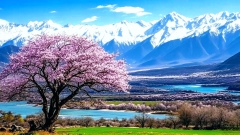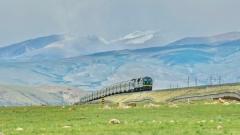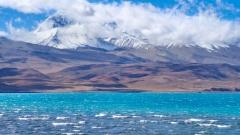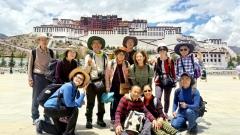For followers of Buddhism, Bön, Hinduism and Jainism, the kora (circumambulation) around Kailash is the ultimate act of devotion. For non-religious visitors, the kora is a dramatic high-altitude trek through glaciers, rocky passes, stark valleys and prayer-flagged ridges that encapsulates the Tibetan landscape and spirit.
This guide focuses on the outer kora – the 54 km circuit most visitors take – and the commonly used 3-day trekking itinerary that begins and ends in Darchen with overnight stays at Dirapuk and Zutulpuk.
Overview of the Kailash Kora: Inner Ring vs Outer Ring
There are two traditional circuits around Mount Kailash:
Inner Ring
The inner ring circles Nandi Parvat on the south side of the sacred massif. It is the shorter but far more physically demanding and esoteric route reserved for highly committed pilgrims. Traditionally it is not arranged for general travellers and is attempted only by those who have completed many outer laps.
Outer Ring
The outer ring is the well-known 54 km kora that most visitors walk (or prostrate along) over 1–3 days. It hugs the base of Kailash and crosses high passes, including the famous Drom La (Droma La). This is the route described in the itinerary below and is achievable for fit trekkers with good acclimatization.
Quick Summary of 3-Day Outer Kora Itinerary
- Day 1: Darchen → Dirapuk (camp/monastery) — ~15 km trek, 7–11 hours, altitude up to ~5,210 m.
- Day 2: Dirapuk → Zutulpuk — ~22 km, 11–14 hours, cross Drom La (5,630 m). Most challenging day.
- Day 3: Zutulpuk → Darchen — ~9 km trek + 3 km eco-bus, 2–5 hours; option to continue to Lake Mansarovar.
Now let’s unpack each day and explain what to expect, how to prepare and practical tips for a safe and respectful kora.

Mount Kailash Kora Route Map
Day 1: Darchen to Dirapuk – Begin the Kora
Starting Point: Darchen and Tarboche Square
Most treks begin in Darchen, a small settlement that functions as the southern base camp for Kailash pilgrims. Early on the first trekking day visitors usually board an eco-bus to Tarboche Square, where the kora officially begins. The square is lively with pilgrims, prayer flags and the first views of Kailash.
Trail highlights and route profile
From Tarboche, the trail moves toward Qugu Temple and descends into the Sarshung valley. Expect a mixed terrain of wide valley walking and initial climbs. After roughly 7 km you’ll reach a post station run by Tibetans — a useful rest point for tea and basic lunch. Because you’ll be operating at high altitude, plan a conservative walking pace and stop often to regulate breathing and heart rate.
Toward late afternoon, the path climbs again for roughly 3 km to reach the cluster of tents and alpine inns near Dirapuk Monastery (camping point ~5,210 m). Dirapuk is prized for some of the best views of Kailash’s southern face — an ideal place for sunset, sunrise photography and the first night under Tibetan stars.
What to expect at Dirapuk
Dirapuk is a rustic mix of teahouses, tents and a monastery. The temperature swings widely between day and night and sudden snowstorms can happen even outside winter. Bring warm layers, a reliable sleeping bag and a headlamp. Food here is basic; bring energy snacks and electrolyte powders to top up between meals.
Day 2: Dirapuk to Zutulpuk – The Crucial Pass Day
The challenge described
Day 2 is the crux of the kora — the longest and most demanding section. You’ll cross several passes, including the highest and most famous, Drom La (5,630 m). Expect a day of steep ascents, loose scree and rocky slopes, plus long high-altitude walking that can stretch 11–14 hours depending on conditions and pace.
The ascent to Drom La
From Dirapuk you climb gradually at first and then steadily to the base of the final ascent. The last kilometers to Drom La are steep and often require careful foot placement — gravel and scree mean you must watch each step. The highest sections are exposed to wind and cold; plan frequent short breaks and drink regularly.
At the Drom La pass you’ll encounter mani piles and a swathe of prayer flags snapping in the wind — a powerful spiritual moment for many pilgrims. From here the slope descends into a long valley where serenity replaces the strain of the climb.
Mid-day and valley walking
After the pass the trail drops into a broad valley. You will likely stop at a nomadic tent or teahouse for lunch (for example Shabjay Dakpo area), where simple soups, tsampa and tea are common. The descent continues and the path eventually leads to Zutulpuk (camping point E), a historical monastic site associated with Milarepa and Naro Bonchung.
The arrival at Zutulpuk
Zutulpuk lies at about 4,790 m. After such a physically draining day, the monastery compound and quiet valley feel restorative. Rest well, stretch the legs and prepare for the short final day. Nights can be cold and windy; check your sleeping arrangements and layer up.
Day 3: Zutulpuk to Darchen – Finishing the Kora
The final stretch
Day 3 is relatively gentle: about 9 km of walking that completes the kora loop and a short eco-bus ride (3 km) back to Darchen. Many trekkers find this day joyful — the mental release of completing the circumambulation and the final vistas of Kailash make the day special.
Post-kora options: Mansarovar Lake
After returning to Darchen you can rest or continue toward Lake Mansarovar (~40 km southwest). On a clear day the turquoise sweep of Mansarovar is a glorious sight; some visitors walk a short section of lakeshore as a gentle post-kora activity. Many tour operators combine Kailash kora with a Mansarovar visit for a richer pilgrimage circuit.
Gear Checklist: What to Bring for Kailash Kora
- Sturdy trekking boots with ankle support and a broken-in sole.
- Layering system: base layer, insulating mid layer, windproof/waterproof outer shell.
- Warm hat, neck gaiter and gloves. Temperatures drop sharply at night.
- Sleeping bag rated to at least –10°C (depending on season).
- Daypack (20–30 L) with rain cover.
- Trekking poles to help on scree and steep descents.
- Water bottles or hydration bladder and water purification tablets.
- High-energy snacks (nuts, chocolate, energy bars), electrolyte mixes.
- Sun protection: high-SPF sunscreen, sunglasses (UV protection) and a sun hat.
- Headlamp with spare batteries, basic first-aid, blister kit.
- Personal medications and altitude medication if prescribed.
- Passport, permits and copies in a waterproof sleeve.
Seasonal Advice: When To Trek Kailash
Best months
September and October are widely regarded as the best months: stable weather, clear skies and comfortable daytime temperatures. Generally, May to October is considered suitable for travel, with caution around the monsoon peak (July–August) when rain and unstable road conditions increase.
Festivals and spiritual timing
Saga Dawa, a major Tibetan Buddhist festival that celebrates the birth, enlightenment and parinirvana of the Buddha, occurs on the 15th day of the fourth month of the Tibetan lunar calendar (date varies each Gregorian year). On this day a Mani flag hanging ceremony takes place at Kailash and many pilgrims believe circumambulating during Saga Dawa brings greater spiritual merit. If you plan to coincide with local festivals note that lodgings and transport can be busier.
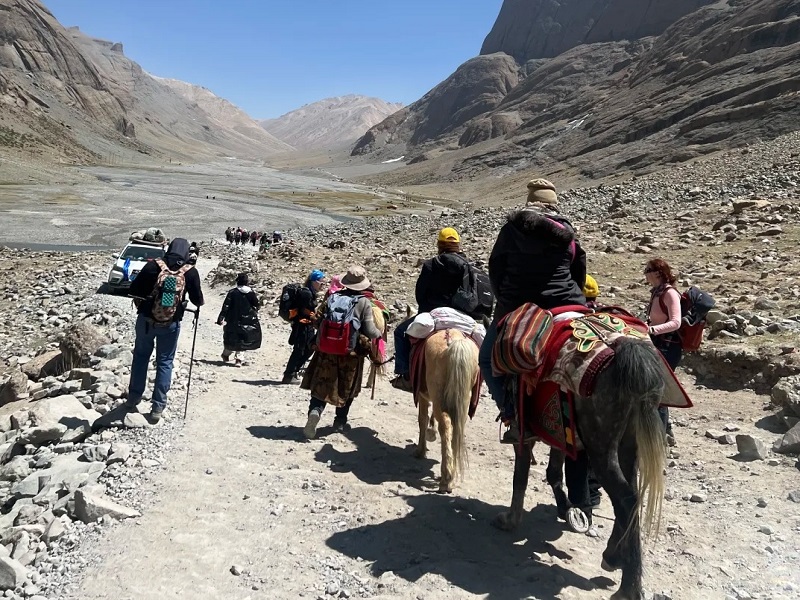
Cultural Etiquette and Respectful Behavior
- Always be respectful around prayer flags, mani walls and shrine sites. Do not step over prayer flags and avoid discarding litter.
- Ask permission before photographing people, especially pilgrims. A small gesture of respect in local dress or when entering monastery grounds goes far.
- Dress modestly at religious sites. Remove hats inside the monastery and speak softly.
- If invited into a nomadic tent or teahouse, accept tea politely. A small offering or tip for hosts is appreciated.

Safety, Permits and Practicalities for Kailash Kora
Permits and Tibetan travel regulations
Travel to Mount Kailash typically requires permits and must usually be arranged through an authorized travel operator. Foreign visitors to Tibet need a Tibet Travel Permit and additional local permits for remote border or pilgrimage areas. Work with a licensed operator to organize transport, permits and lodging to ensure compliance and a smooth trip.
Weather and road conditions
Road access in Tibet depends on season and weather. Snow, rain and landslides can delay movement. Be flexible with schedules and mentally prepare for possible route changes.
Local support and logistics
Hiring experienced local guides, drivers and support staff will improve both safety and cultural understanding. Local guides help manage altitude pacing, locate water and food stops, and provide rich context about sacred sites.
Tips To Make Your Kora Better
- Walk slowly and steadily — “pole pace” wins on high relief.
- Eat small frequent meals and keep sipping water rather than gulping.
- Bring a small journal or camera to capture impressions; the light on the plateau is remarkable.
- Use trekking poles to save knees on the descent after Drom La.
- Respect silence and ritual spaces; sometimes the most powerful moments are quiet and personal.
A Kailash kora is a journey of contrasts: long hours of exertion followed by sudden spiritual intensity; austere high-altitude landscapes softened by prayer flags, mani walls and the warmth of nomadic hospitality. Whether you walk the outer ring as a trekker chasing alpine panoramas or as a pilgrim seeking merit, the circuit leaves a lasting imprint — on lungs, on feet and often on the heart.







